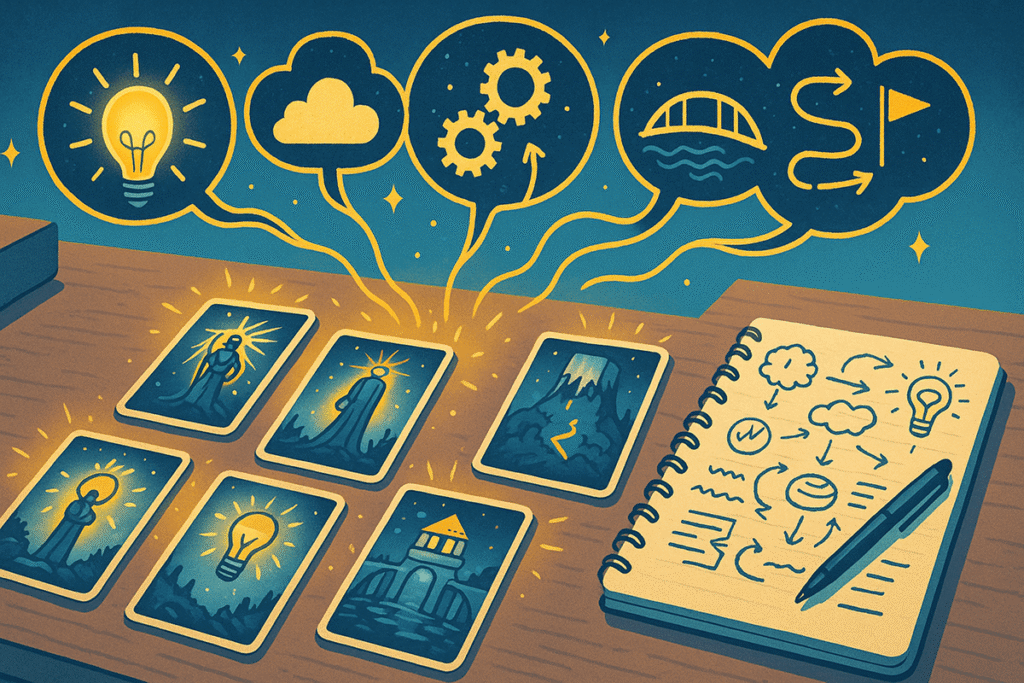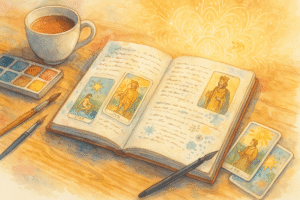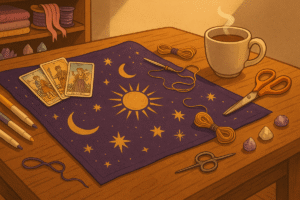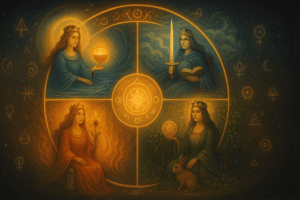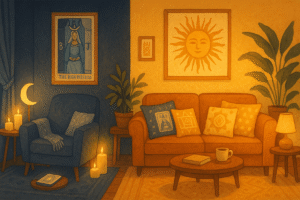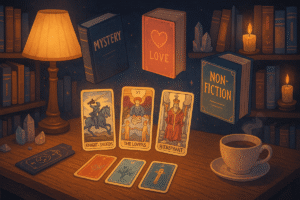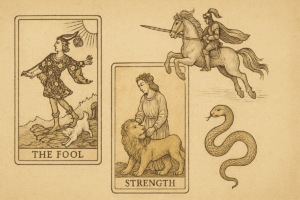Table of Contents
When I first suggested using tarot cards in a business meeting, I got some interesting looks. But here’s what happened next: we generated more innovative solutions in thirty minutes than we had in weeks of traditional brainstorming sessions. The cards didn’t predict our future success, but they did something perhaps more valuable. They cracked open our thinking patterns and invited fresh perspectives into the room.
Tarot for brainstorming isn’t about fortune telling or mystical predictions. Instead, it’s about leveraging the rich symbolism and archetypal imagery of tarot cards as creative prompts. Think of each card as a visual brainstorming catalyst, designed to push your mind beyond its usual pathways and into unexplored territory.
Why Traditional Brainstorming Sometimes Falls Short
Most of us have sat through brainstorming sessions that felt more like idea graveyards than creative hotbeds. We stare at blank whiteboards, rehash the same tired concepts, or get stuck in analysis paralysis. Our brains, comfortable in their established neural pathways, often circle back to familiar solutions.
The human mind craves patterns and predictability. While this serves us well in many situations, it can become a creative limitation when we need breakthrough thinking. We unconsciously filter potential ideas through our existing frameworks, dismissing concepts that don’t immediately seem relevant or practical.
This is where tarot’s seemingly random nature becomes a strategic advantage. The cards force us to consider perspectives we might never have encountered otherwise. A card depicting a figure climbing a mountain might prompt questions about gradual progress, while an image of crossed swords could spark thoughts about conflict resolution or competing priorities.
The Psychology Behind Visual Brainstorming
Research in cognitive psychology suggests that visual stimuli can bypass our logical filters and activate different areas of the brain. When we encounter an unexpected image, our minds automatically begin making connections, searching for patterns and meanings. This process, called lateral thinking, is exactly what we want to encourage during brainstorming sessions.
Tarot cards are particularly effective visual prompts because they contain layers of symbolism. A single card might feature human figures, natural elements, architectural structures, and abstract symbols. Your eye might be drawn to the stormy sky in the background, while someone else focuses on the figure’s determined expression. These different focal points can lead to entirely different creative insights.
I’ve noticed that people often apologize when sharing ideas sparked by tarot cards, as if they need to justify the connection. “This might sound weird, but when I see this tower crumbling, I think about…” But here’s the thing: weird connections often lead to breakthrough innovations. The goal isn’t logical consistency; it’s creative expansion.
Setting Up Your Brainstorming Session
Before diving into specific spreads, let’s establish the right mindset and environment. First, frame the session clearly for all participants. Explain that you’re using tarot cards as creative prompts, not seeking predictions or supernatural guidance. This helps skeptical team members engage without discomfort.
Choose a space where people can spread out cards and take notes comfortably. Good lighting is essential since you’ll be examining card details closely. I prefer natural light when possible, though any bright, even illumination works fine.
Keep the atmosphere relaxed but focused. Some background music can help, but avoid anything too distracting. The goal is to create a space where unconventional ideas feel welcome and judgment is suspended.
Consider starting with a brief warm-up exercise. Ask participants to look at a single card and share the first three things they notice, no matter how mundane. This helps people get comfortable with the process of extracting meaning from imagery.
The Creative Catalyst Spread
This five-card spread is designed specifically for brainstorming and problem-solving. Unlike traditional tarot spreads that might explore past influences or future outcomes, every position in this spread focuses on present-moment creative exploration.
Position 1: The Challenge Reframed Draw one card and ask: “What’s another way to look at this problem?” The card’s imagery might reveal hidden assumptions you’ve been making or suggest a completely different angle of approach. A card showing a figure looking backward might prompt you to consider what historical solutions could be updated for current use.
Position 2: The Unexpected Resource This card represents assets, skills, or opportunities you might be overlooking. Perhaps you see a card with multiple figures and realize you haven’t been leveraging your team’s diverse backgrounds. Or maybe an image of someone juggling reminds you that your ability to manage multiple projects could actually be an advantage rather than a distraction.
Position 3: The Hidden Obstacle What challenges aren’t you seeing clearly? This card often reveals blind spots or resistance points you haven’t fully acknowledged. An image of a figure trapped between two choices might highlight decision paralysis, while a card showing someone walking away could point to commitment issues.
Position 4: The Unconventional Approach Here’s where things get interesting. This card should push you toward solutions that break conventional wisdom. Let your imagination run wild with the symbolism. If you see a card with someone dancing, maybe your business problem needs a more playful, experimental approach. A card featuring nighttime imagery might suggest that what you think of as obstacles could actually be advantages in the right context.
Position 5: The Next Small Step The final card grounds your brainstorming in actionable next steps. Look for small, concrete actions suggested by the card’s imagery. A card showing someone writing might suggest that documenting your ideas is the crucial next move, while an image of people gathering could indicate that bringing in additional perspectives is your immediate priority.
Making Connections That Matter
The real magic happens in the connections between cards, not just individual interpretations. Look for themes, contradictions, or unexpected relationships across the spread. Maybe three cards feature water imagery, suggesting that emotional considerations are more important to your solution than you realized. Or perhaps you notice that several cards show figures in motion, hinting that action is preferable to further analysis.
Don’t force connections that aren’t there, but do look for patterns with fresh eyes. Sometimes the most powerful insights come from apparent contradictions. If one card suggests moving quickly while another emphasizes patience, perhaps your solution involves a phased approach with both urgent and gradual components.
I’ve found that the most productive brainstorming sessions happen when people build on each other’s interpretations. Someone might see leadership themes in a card while another person focuses on the collaborative elements shown in the same image. Both perspectives can be valid and valuable for generating solutions.
Beyond the Spread
Once you’ve worked through the formal spread, consider these additional techniques to deepen your brainstorming session. Try the “random card pull” method: when you hit a creative wall during discussion, draw a single card and ask how its imagery might apply to whatever challenge you’re facing in that moment.
You can also use cards for role-playing exercises. If you’re working on a customer service challenge, draw cards to represent different customer types and brainstorm solutions for each personality or situation suggested by the imagery.
For ongoing projects, consider keeping a “project card” that you draw at the beginning of each planning session. Track how your interpretations of the same card evolve as your project develops. You might be surprised by how new meanings emerge as your understanding deepens.
Integrating Insights Into Action
The most creative brainstorming session is worthless without follow-through. As you work with the cards, designate someone to capture key insights and potential action items. Don’t worry about organizing everything perfectly during the session; focus on quantity over quality initially.
After the brainstorming session ends, take time to review and refine the ideas that emerged. Some concepts that seemed brilliant in the moment might not hold up to practical scrutiny, and that’s perfectly fine. Others might need significant development before they’re ready for implementation.
Consider creating a “parking lot” for interesting ideas that aren’t immediately actionable. These concepts might become relevant later as circumstances change or as other pieces of your solution puzzle fall into place.
When Tarot Brainstorming Works Best
This approach is particularly effective for challenges that have already been approached through conventional methods without satisfactory results. If you’re dealing with interpersonal dynamics, creative projects, or situations requiring innovative thinking, tarot’s symbolic richness can provide valuable new perspectives.
I’ve seen this method work well in diverse contexts: marketing teams developing campaign concepts, nonprofit organizations designing community programs, and individuals working through career transitions. The key is approaching the process with genuine openness to unexpected insights.
However, I should mention that tarot brainstorming might not be ideal for highly technical problems requiring specialized expertise, or in situations where stakeholders are deeply uncomfortable with anything that seems unconventional. Read your audience and choose your moments wisely.
The beauty of using tarot for brainstorming lies not in any mystical properties of the cards themselves, but in their ability to interrupt our habitual thinking patterns. They serve as creative catalysts, pushing us to consider possibilities we might never have explored otherwise. Whether you’re tackling a business challenge, planning a creative project, or simply trying to approach a personal situation from a fresh angle, these ancient images can offer surprisingly modern insights into the art of innovative thinking.
Frequently Asked Questions
Do I need to know traditional tarot meanings to use cards for brainstorming?
Not at all—you can use tarot cards for brainstorming without any prior knowledge of their traditional meanings. The imagery alone serves as your creative prompt. Focus on what you personally see in the cards: the colors, figures, objects, and scenes. Your own interpretations and immediate reactions to the visual elements are often more valuable for brainstorming than memorized card definitions.
What type of tarot deck works best for brainstorming sessions?
Choose a deck with illustrated scenes on all the cards, not just simple pip designs, since story-rich imagery provides better brainstorming material. Popular options include the Rider-Waite deck and its variations, which feature detailed imagery on every card. The key is selecting a deck where each card tells a visual story you can engage with, regardless of whether you understand its traditional symbolism.
Can I use this method for business or professional projects, or is it just for creative endeavors?
Tarot brainstorming has been successfully used in corporate settings for planning sessions, marketing strategy, product development, and solving workplace challenges. The technique works equally well for business strategy, product launches, team building exercises, and professional problem solving as it does for artistic or personal projects. The cards simply serve as neutral visual prompts that work across any context.
How many cards should I pull during a brainstorming session?
Start with the five card spread described in this article, which provides structure without overwhelming you. For more open-ended brainstorming, you can draw one to three cards and generate multiple ideas from each before moving forward. There’s no fixed rule; adjust based on your time constraints and how many ideas you need. Some sessions might benefit from just one card explored deeply, while complex problems might warrant working through multiple cards.

